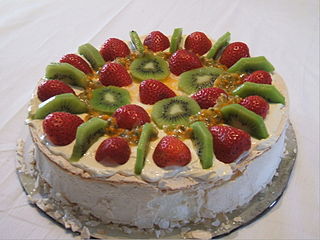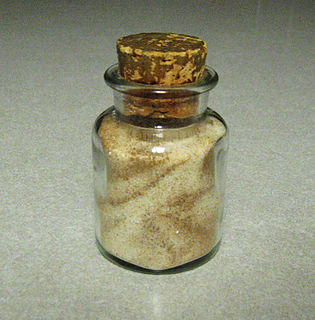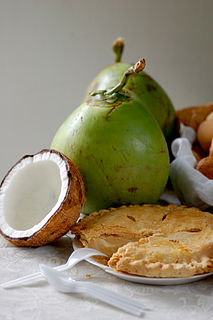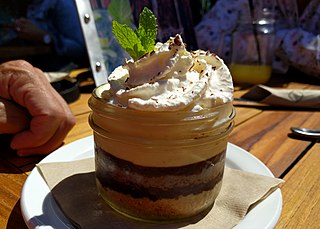Patents
- Dry grater [7]
- Meringue pie [8]
- Pie marker, method of finishing meringue pies and the resulting meringue pie [9]
- Method of making fruit pie [10]
Monroe Boston Strause was an American piemaker whose innovations included graham-cracker crust, chiffon pie, and black-bottom pie. He was a "pie celebrity" whose name was "a household word." [1]
Strause was born in 1900 in Los Angeles. In 1919 he was hired by his uncle who ran a wholesale pie business. In his early twenties, Strause took over the business, following his uncle's retirement. He became a consultant in the 1930s after selling his company. [1]
Because of improvements in oven reliability and consistency, homemade and increasingly complex cakes had been overtaking pie as a popular American dessert, which inspired Strause to his experimentations. [1] He considered pie to be the "Great American Dessert," superior to most other foods. [2]
Strause's technique was more scientific in nature; he called his recipes "formulas." The publisher of his book Pie Marches On described it this way: "He has reduced pie baking to an exact science and measures each ingredient with the care of a pharmacist." His focus on quality combined with secrecy and showmanship allowed him, according to The Globe & Mail , to earn "a bank president’s salary out of pie." [2]
He was an early pioneer of the celebrity chef ethos. [2] In 1960, Strause was hired as a consultant by Cannon Foods Inc. of Bridgeville, Delaware, to create recipes based on Cannon food products. [3]
Strause and his wife Violet Marian had a daughter, born May 21, 1938, [4] and a son. [5]
He died in 1981. [6]

Pavlova is a meringue-based dessert. Originating in either Australia or New Zealand in the early 20th century, it was named after the Russian ballerina Anna Pavlova. Taking the form of a cake-like circular block of baked meringue, pavlova has a crisp crust and soft, light inside. The confection is usually topped with fruit and whipped cream. The name is pronounced, or like the name of the dancer, which was.

A pie is a baked dish which is usually made of a pastry dough casing that contains a filling of various sweet or savoury ingredients. Sweet pies may be filled with fruit, nuts, brown sugar, sweetened vegetables, or with thicker fillings based on eggs and dairy. Savoury pies may be filled with meat, eggs and cheese (quiche) or a mixture of meat and vegetables.

Meringue is a type of dessert or candy, often associated with Swiss, French, Polish and Italian cuisines, traditionally made from whipped egg whites and sugar, and occasionally an acidic ingredient such as lemon, vinegar, or cream of tartar. A binding agent such as salt, flour or gelatin may also be added to the eggs. The key to the formation of a good meringue is the formation of stiff peaks by denaturing the protein ovalbumin via mechanical shear. Its flavorants are vanilla, a small amount of apple juice, or orange juice, although if extracts of these are used and are based on an oil infusion, an excess of fat from the oil may inhibit the egg whites from forming a foam.

Lemon meringue pie is a type of dessert pie, consisting of a shortened pastry base filled with lemon curd and topped with meringue.

A wedding cake is the traditional cake served at wedding receptions following dinner. In some parts of England, the wedding cake is served at a wedding breakfast; the 'wedding breakfast' does not mean the meal will be held in the morning, but at a time following the ceremony on the same day. In modern Western culture, the cake is usually on display and served to guests at the reception. Traditionally, wedding cakes were made to bring good luck to all guests and the couple. Nowadays, however, they are more of a centerpiece to the wedding and are not always even served to the guests. Some cakes are built with only a single edible tier for the bride and groom to share, but this is rare since the cost difference between fake and real tiers is minimal.

Dulce de leche, also known as caramelized milk or milk jam in English, is a confection from Latin America prepared by slowly heating sugar and milk over a period of several hours. The resulting substance, which takes on a spreadable, sauce-like consistency, derives its rich flavour and colour from non-enzymatic browning. It is typically used to top or fill other sweet foods.

Baked Alaska, also known as Bombe Alaska, omelette norvégienne, omelette surprise, or omelette sibérienne depending on the country, is a dessert consisting of ice cream and cake topped with browned meringue. The dish is made of ice cream placed in a pie dish, lined with slices of sponge cake or Christmas pudding, and topped with meringue. The entire dessert is then placed in an extremely hot oven for a brief time, long enough to firm and caramelize the meringue but not long enough to begin melting the ice cream.

Chocolate puddings are a class of desserts in the pudding family with chocolate flavors. There are two main types: a boiled then chilled dessert, texturally a custard set with starch, commonly eaten in the U.S., Canada, Germany, Sweden, Poland, and East and South East Asia; and a steamed/baked version, texturally similar to cake, popular in the UK, Ireland, Australia, Germany and New Zealand.

A macaron or French macaron is a sweet meringue-based confection made with egg white, icing sugar, granulated sugar, almond meal, and food colouring.

A Boston cream pie is a cake with a cream filling. The dessert acquired its name when cakes and pies were cooked in the same pans, and the words were used interchangeably. In the late 19th century, this type of cake was variously called a "cream pie", a "chocolate cream pie", or a "custard cake".

Cinnamon sugar is a mixture of ground cinnamon and granulated sugar used as a spice to flavor foods such as Belgian waffles, Snickerdoodle cookies, tortillas, coffee cake, French toast, and churros. It is also used to flavor apples, cereals, and other fruits. As McCormick describes cinnamon sugar, "it’s the comforting scent of Sunday morning cinnamon toast and mid-summer’s peach cobbler...the aroma of the holidays, with cinnamon cookies and spice cake."

A chiffon pie is a type of pie that consists of a special type of airy filling in a crust. The filling is typically produced by folding meringue into a mixture resembling fruit curd that has been thickened with unflavored gelatin to provide a light, airy texture; it is thus distinguished from a cream pie or mousse pie, which achieve lightness by folding in whipped cream rather than meringue. To reduce risk of salmonella, it is recommended that a Swiss-meringue be used instead of using raw whipped egg whites. This filling is then put into a pre-baked pie shell of variable composition and chilled. This same technique can also be used with canned pumpkin to produce pumpkin chiffon pie.

Buko pie, sometimes anglicized as coconut pie, is a traditional Filipino baked young coconut (malauhog) custard pie. It is considered a specialty in the city of Los Baños, Laguna located on the island of Luzon.

Sponge cake is a light cake made with egg whites, flour and sugar, sometimes leavened with baking powder. Sponge cakes, leavened with beaten eggs, originated during the Renaissance, possibly in Spain. The sponge cake is thought to be one of the first of the non-yeasted cakes, and the earliest attested sponge cake recipe in English is found in a book by the English poet Gervase Markham, The English Huswife, Containing the Inward and Outward Virtues Which Ought to Be in a Complete Woman (1615). Still, the cake was much more like a cracker: thin and crispy. Sponge cakes became the cake recognized today when bakers started using beaten eggs as a rising agent in the mid-18th century. The Victorian creation of baking powder by English food manufacturer Alfred Bird in 1843 allowed the addition of butter to the traditional sponge recipe, resulting in the creation of the Victoria sponge.

The Midpoint Café, a restaurant, souvenir and antique shop on US Route 66 in Adrian, Texas, bills itself as geographically the midway point between Los Angeles and Chicago on historic Route 66. Signage in Adrian proudly declares a 1139-mile distance to each original US 66 endpoint; the café's slogan is "when you're here, you're halfway there".

Milk Bar is a chain of dessert and bakery restaurants in the United States, founded by chef Christina Tosi. Tosi owns the chain with the Manhattan-based Momofuku restaurant group; Momofuku does not control the operations of Milk Bar.
Elizabeth Goodfellow (c.1767–1851), generally called Mrs. Goodfellow, started one of the first cooking schools in America. She taught classes for thirty years, and her recipes and techniques were passed on for generations in the cookbooks of one of her students, Eliza Leslie. Goodfellow also ran a renowned bakery and confectionery in Philadelphia during the first fifty years of the 19th century.

Black bottom pie is a type of pie originating in the United States that features a layer of chocolate pastry cream or pudding, the "black bottom," topped with whipped cream or meringue. The single crust is pre-baked and of variable composition, but a graham cracker crust is common.
Pie in American cuisine has roots in English cuisine and has evolved over centuries to adapt to American cultural tastes and ingredients. The creation of flaky pie crust shortened with lard is credited to American innovation.